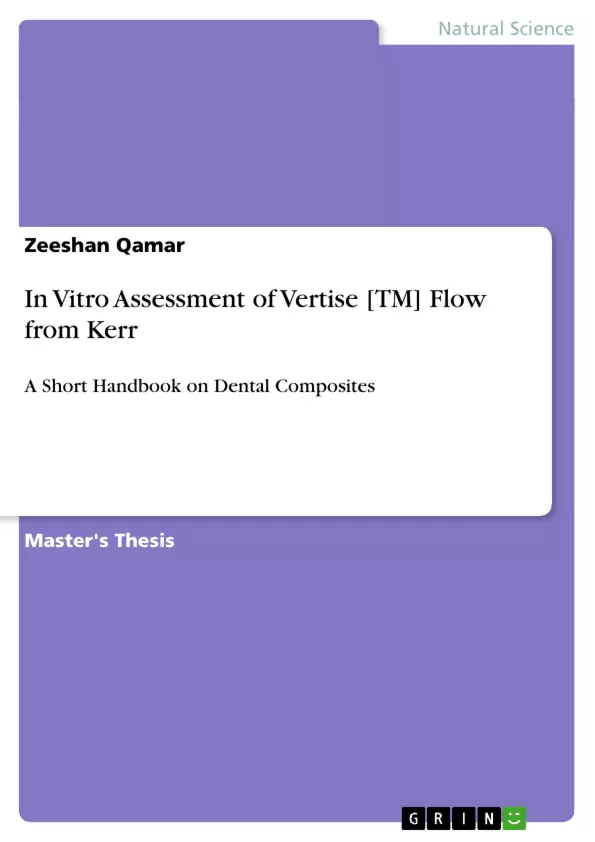Introduction:
Flowable composites are of low viscosity and a modification of small particle-filled and hybrid composites. They have reduced filler load and modified resin monomers which provide a consistency that allows the material to flow readily. They have better adaptability to cavity walls thus preventing microleakge. However their lower filler loading results in greater polymerisation shrinkage and reduced mechanical properties compared to other hybrid composites.
Aims and Objectives:
The aim of this study was to compare the physical and mechanical properties of a new low viscosity commercial flowable composite (VertiseTM Flow) with other flowable composites (Grandio Flow and Premise Flowable) currently available on the market. Water absorption, depth of cure, degree of conversion (using FTIR) and polymerisation exotherm were compared.
Material and Methods:
Water absorption and desorption was measured in distilled water and artificial saliva gravimetrically, where the uptake and loss was noted at set time intervals. Degree of conversion of double bonds of uncured and cured samples of composites was measured using the FTIR. The depth of cure was measured by an adapted ISO 4049 stated method. Finally polymerisation exotherm was measured using the K-type thermocouple of samples cured for 20 seconds.
Results:
The results showed increased uptake of water in distilled water and artificial saliva for VF, compared to the PF and GF. The diffusion coefficients were generally similar for desorption and absorption. The solubility % in distilled water was highest for VF in artificial saliva. All materials showed weight gain after desorption. Finally the depth of cure of VF was lower and polymerisation exotherm was higher than PF and GF. Lastly degree of conversion was found to be almost similar for all the three flowable composites.
Conclusions:
The presence of HEMA in VF resulted in a higher water uptake and polymerisation exotherm and lower depth of cure than the other flowable composite tested.
Inhaltsverzeichnis (Table of Contents)
- CHAPTER 1: INTRODUCTION
- CHAPTER 2: LITERATURE REVIEW
- 2.1 INTRODUCTION
- 2.2 DENTAL COMPOSITES
- 2.2.1 COMPOSITION AND STRUCTURE
- 2.2.2 RESIN/ORGANIC MATRIX
- 2.2.3 FILLER
- 2.2.4 COUPLING AGENT
- 2.2.5 INTIATORS AND ACCELERATORS
- 2.2.6 CLASSIFICATION OF COMPOSITES
- 2.2.7 PACKABLE COMPOSITES
- 2.2.8 POLYMERIZATION REACTION
- 2.3 PHYSICAL PROPERTIES OF DENTAL COMPOSITES
- 2.3.1 Working and setting time:
- 2.3.2 Polymerization Shrinkage ..
- 2.3.3 Thermal Properties.........
- 2.3.4 Water Sorption
- 2.3.5 Solubility...........
- 2.3.6 Colour and Colour Stability
- 2.4 MECHANICAL PROPERTIES
- 2.4.1 Strength and Modulus
- 2.4.2 Hardness...
- 2.4.3 Bond Strength and Dental Substrates (Ceramics, Alloys, etc...:....) ..
- 2.5 CLINICAL PROPERTIES
- 2.5.1 Depth of cure for light-cured composites
- 2.5.2 Radiopacity
- 2.5.3 Wear Rates
Zielsetzung und Themenschwerpunkte (Objectives and Key Themes)
This study aims to compare the physical and mechanical properties of a new low viscosity commercial flowable composite (Vertise Flow) with other flowable composites (Grandio Flow and Premise Flowable) currently available on the market. The research investigates water absorption, depth of cure, degree of conversion, and polymerization exotherm of these materials.
- Physical and mechanical properties of flowable composites
- Comparison of Vertise Flow with other commercially available flowable composites
- Water absorption and desorption in distilled water and artificial saliva
- Depth of cure and polymerization exotherm
- Degree of conversion of double bonds in uncured and cured samples
Zusammenfassung der Kapitel (Chapter Summaries)
Chapter 1: Introduction introduces the concept of flowable composites, highlighting their low viscosity and properties. It discusses the advantages and disadvantages of these materials, particularly their lower filler loading which leads to greater polymerization shrinkage and reduced mechanical properties.
Chapter 2: Literature Review delves into the composition and structure of dental composites. It explores the various components, including the resin/organic matrix, filler, coupling agent, initiators, and accelerators. This chapter also covers different classifications of composites, the polymerization reaction, and a detailed examination of physical and mechanical properties like working and setting time, polymerization shrinkage, thermal properties, water sorption, solubility, color stability, strength, modulus, hardness, and bond strength. The chapter concludes by discussing clinical properties like depth of cure, radiopacity, and wear rates of light-cured composites.
Schlüsselwörter (Keywords)
Flowable composites, Vertise Flow, Grandio Flow, Premise Flowable, water absorption, depth of cure, degree of conversion, polymerization exotherm, dental materials, physical properties, mechanical properties, clinical properties.
- Citar trabajo
- Zeeshan Qamar (Autor), 2012, In Vitro Assessment of Vertise [TM] Flow from Kerr, Múnich, GRIN Verlag, https://www.grin.com/document/202393

![Título: In Vitro Assessment of Vertise [TM] Flow from Kerr](https://cdn.openpublishing.com/thumbnail/products/202393/large.webp)

